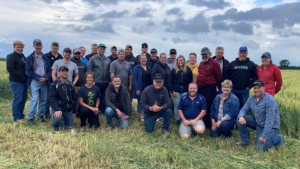Grazing cover crops
PARTNERSHIPS BRING MANURE, BIOMASS MANAGEMENT

MORE FARMERS ARE realizing the benefits of cover crops in grain rotations. They are also valuable for livestock, though. Partnerships with livestock farmers can bring economic and environmental benefits to both production systems.
In a seminar hosted by the Ontario Ministry of Agriculture, Food and Rural Affairs and Beef Farmers of Ontario in November 2022, sheep farmers Lyndsey Smith and Chris Moore of Shady Creek Lamb Co. shared their experiences, lessons, and how cover crop grazing has benefited both their business and the grain farmers with whom they partner.
Mark Brock, Huron County grain grower and former Grain Farmers of Ontario chair, also shared how farmers can develop better partnerships through a better understanding of psychology — and specifically, apprehension of risk.
BETTER WEIGHT GRAIN AND RESIDUE MANAGEMENT
Cover crop grazing was a natural fit for Lyndsey Smith and Chris Moore’s Ottawa-area sheep business. The pair already graze sheep in pasture under solar panels from May to October, but the ability to graze cover crops later in the year helped extend the grazing season well into winter.
“One of the things with [ewe lambs] on cover crops is we’re really trying to push them to grow as fast, as big as we can,” says Moore. “Because we know if they can make it to 80 pounds, they’re that much more likely to breed and lamb as yearlings, and that’s a big profit driver in the sheep business.”
However, a limited land base made it necessary to partner with neighbouring farms. Smith and Moore partnered with neighbours who, before entering into a cover-crop grazing agreement, had goals that fit well with what Smith and Moore were trying to achieve—garnering the fertility and organic matter afforded by manure, for example, or managing an amount of biomass which could cause problems at planting.
Smith and Moore secured several cover crop grazing sites in 2021 and 2022. In the first year, the sheep grazed off the cover crops the farmer had already planted; in 2022, they paid for the cover crop seed — oats and peas proved to be their flock’s most preferred forage blend. They also covered the cost and effort of planting, as well as all aspects of herd management. Aside from fertility returns afforded by manure, Smith and Moore say their partnering landowners found additional benefits. One landowner, for example, found cover crop grazing to be so effective at residue management that he was comfortable changing the cropping strategy the following spring.
“We can both work together, and both win… it’s working well, and we’re pretty excited about it,” says Smith. The pair reiterated that the mutually-beneficial system was only possible because they communicated the idea to trusted neighbours. They encourage others to do the same, actually put agreements to paper, and understand it is a learning process.
“Cover crops are just such fantastic feed … the one thing I look for are people that are really good farmers, that are really busy, whether that’s just they have a really big busy farm, or they’re busy off-farm, and they want to have the value of manure, the benefits of cover crops — and they don’t want the commitment of livestock,” says Moore.
“You can’t be a perfect person and manage livestock, crops, machines, and marketing, so you might as well partner up.”
FARMER PSYCHOLOGY – HOW IT AFFECTS COLLABORATION
Agreements in which both parties benefit might make good business sense — but that doesn’t mean the person being approached will be willing to participate. Indeed, apprehension and the overly strong fear of loss are very common among farmers, which can be a major barrier to what would otherwise be very successful partnerships.
It is the lesson Mark Brock learned while pursuing his Nuffield Scholarship thesis — “Farmer to Farmer Collaborations.” His experiences meeting with farmers and discussing their partnerships with one another revealed many successful examples, as well as what common psychological barriers often need to be overcome before such partnerships can work.
Overconfidence and the idea that you know better, sticking with the status quo because it is more comfortable and easy to do so, not being exposed to working examples of what is being proposed — these and other cognitive biases can all prevent otherwise beneficial partnerships from coming to fruition.
“We have this individualistic approach … that’s kind of inherent in our DNA a little bit, and it adds a challenge looking at how we do collaborations,” says Brock. His experience suggests farmers in Canada and the United States are particularly susceptible to overly individualistic thinking.
Brock says successful partnerships account for both the economic and the psychological. The agreement has to make the prospect of gain outweigh the fear of loss. A recipe for positive collaboration, in his experience, contains formal agreements — even simple ones — rooted in common goals and legwork to find the right people.
“I think it helps understanding the challenges you have when you want to maybe collaborate with a farmer that you, kind of, have to be a bit selective … around trying to find people that you can talk about these ‘buts,'” says Brock, later reiterating the role documentation can play in developing comfortable partnerships.
“It might be a single piece of paper that lists the land owner’s goals or the grain farmer’s goals, and your goals as a livestock raiser so that you both can look and identify it — and measure your success against that.” •

























